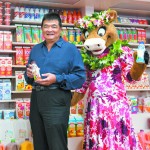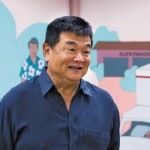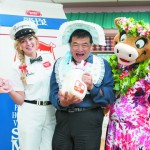Deja Moo – 60 Years Of Healthy Baby Contests
By LANI MOO as told to Susan K. Sunderland
Told as a young man that a local guy could never become president of Hawaii’s largest dairy company, Glenn Muranaka persevered and has been the ‘lead steer’ since 1996. With dairy consumption declining, Meadow Gold is branching into new products while touting milk’s healthy protein and calcium. And best of all, it’s Island-fresh
- Glenn Muranaka with Hawaii’s favorite cow Lani Moo. Photo by Anthony Consillio
- Glenn Muranaka: ‘There is no beverage with the nutrition of milk’. Photo by Anthony Consillio
- Meadow Gold celebrates the 60th anniversary of its iconic Healthy Baby Contest. Dressing up for the occasion is Meadow Gold president Glenn Muranaka with Hawaii’s favorite cow Lani Moo in her new moo-moo and sidekick Calci. Photo by Anthony Consillio
MOOOOOO!
It’s me. Lani Moo, everyone’s favorite dairy diva. Who says a cow can’t write? You’re reading this, aren’t you?
Don’t overthink it. Just milk the moment for what it’s worth and be enlightened.
On the 60th anniversary of Meadow Gold’s Healthy Baby Contest, I’ve been asked to give some insight to Hawaii’s oldest and largest dairy. Who better to tell that story than the iconic face of the brand?
I have been Meadow Gold’s ambassador for 63 years. During that time, many changes have taken place, including significant trends in milk consumption. More about that later.
As you can see by the photos, even I have made some changes. Purely cosmetic, of course. Not much is needed for a natural beauty like me. My adorable face has been given a facial to smooth out some lines. I have a colorful new wardrobe, thanks to the fashionistas at Iolani Sportswear. They sure know how to bring flair and style to a moo-moo.
If I look more youthful and perky, that’s by design.
I have personified Hawaii’s oldest dairy (forerunner known as Dairymen’s Association) since 1950. The years have been kind to me, but my appeal must extend to a new generation of milk drinkers. It’s udderly essential to be relevant when one is the most famous cow in the state.
But enough about me. Moove over and let’s chew the cud about Meadow Gold Dairies, a kamaaina company that has served the Islands for 110 years.
Someone who knows its history is Glenn Muranaka, president and general manager of Meadow Gold.
Muranaka, a McKinley-Kapiolani Community College-University of Hawaii grad, rose through the ranks at Meadow Gold, starting in 1972 as a statistical clerk at age 22. He was the youngest employee at the time and was mentored by veterans of Hawaii’s golden age of dairy farming.
His thirst for knowledge and problem-solving led him successively to positions of responsibility. He was promoted to accountant and then to office manager. Muranaka became vice president and controller in 1982, senior vice president in 1985, and executive vice president and assistant general manager in 1995.
His elevation to president and general manager in 1996 made him the first islander to manage the state’s major dairy.
“My goal always was to become president,” Muranaka says. “I wanted to be in a position where I could effect positive change. At age 29 I told my boss that I wanted to take his job. I was told ‘no way’ would a Mainland company put a local guy in that position.”
Like pasteurization, the right amount of heat can make a difference. Muranaka expanded his knowledge and understanding of the company’s operations and was outspoken in company meetings.
Eventually he became lead steer.
The dairy industry at the time was experiencing a tumultuous era riveted by pesticide contamination concerns and devastated profits. Rebuilding consumer confidence, employee morale and restoring brand integrity were paramount to survival.
The corporate structure evolved as well. Dairymen’s was purchased by Beatrice Foods (1953), followed by Borden (1986), Southern Foods Group (1997) and Dean Foods Co. of Dallas (2001).
Over time, major decisions affected the closing of farms and converting Neighbor Island plants to distribution centers.
Muranaka responded to the changing landscape by shoring up advertising and public relations to emphasize consumerism and community relations. He has followed this track with rewarding results.
“The barometer of business is the morale of employees,” he states. “There was a time when our workers were embarrassed to wear our uniform. Even legislators were critical of us. It took a tremendous amount of work and sacrifice to turn things around.”
Today, not only has the pride returned, but also profitability. Meadow Gold of Hawaii is a top-performing unit in Dean Foods. This has allowed the dairy processor to celebrate achievements in the face of ever-mounting competition from imports.
“It keeps us on our toes,” the 63-year-old president says. “It’s moo-tivation.”
Among the benchmarks of success are traditions such as Meadow Gold’s Healthy Baby Contest, which observes its diamond jubilee in September.
The annual event, coordinated by the Honolulu Chinese Jaycees, showcases 1-and 2-year-olds who embody physical and personality traits of a robust baby. This year’s preliminary contest takes place Sept. 7, 14 and 21, culminating with the final judging Sept 29, 10 am. to noon, at Ala Moana Centerstage.
Neighbor Island contests are held Aug. 24 on Kaua’i, Oct. 5 on Maui and Oct. 19 on Hawaii.
“We have had many generations of family members participate over the years,” Muranaka says. “Some of our earliest champions now have grandkids of their own.
“The underlying purpose of this contest is to focus on the nutritional value of milk,” he explains. “Healthy babies mirror the benefits of our wholesome, body-building beverage.”
In connection with this year’s event is an online contest at lanimoo.com to identify favorite local celebrities who were beautiful babies. Winner gets a year’s supply of milk and ice cream.
Also tied to the occasion is the introduction of our new promotional ambassador named Calci, who wears the white milkman uniform of fabled Dairymen’s Association and touts milk’s calcium content. Calci will accompany me at community events and school appearances throughout the year.
All of this outreach happens while our dairy industry is coping with mounting competition and changing consumption trends.
In the battle of beverages, milk has admittedly slipped from favor in recent years. The U.S. Department of Agriculture reports that milk consumption has dropped 30 percent since 1975 and 3.3 percent in the last year alone. Food consumption away from home and the increased use of processed foods are reflected in the trend.
At the same time, there is an exploding soft drink and juice market. Sports drinks, bottled water and teas add to the vast choices.
Consumers currently are averaging about one-and-one-half servings a day from dairy foods, only about half the amount recommended by the Food Guide Pyramid. The downward trend in fluid milk is said to reflect a growing demand for low-fat products including cheese, yogurt and frozen desserts.
According to Muranaka, although dairy products contribute only 10 percent of daily calories to the U.S. diet, they supply a significant portion of good nutrition.
“Milk is the perfect food,” he heralds. “There is no beverage with all the nutrition of milk.”
But market share alone isn’t what keeps the dairy dynamo so driven.
“The greater challenge is beyond Meadow Gold,” he offers. “The overriding issue is protecting the lands and water of our state. We’ve got to cultivate agricultural lands for sustainability and not depend heavily on imports for our food supply. We’ve got to incentivize farmers to cultivate the lands. Locally produced products must bear the premium seal of quality.
“This is about caring for Hawaii,” Muranaka adds. “We must bring people together to do good. I do believe there will be dairy farms again. Those farms will need a processor and producer of milk products.”
As the prime processor in town, this positions Meadow Gold well for the future. Its sense of community responsibility is the cream that rises to the top. With charitable programs such as the Lani Moo Fund, Healthy Baby Contest and educational endeavors to promote healthy lifestyles and nutrition, it seems on a viable course.
That’s the real cash cow.
For information on the Healthy Baby Contest and Lani Moo, visit lanimoo.com.






